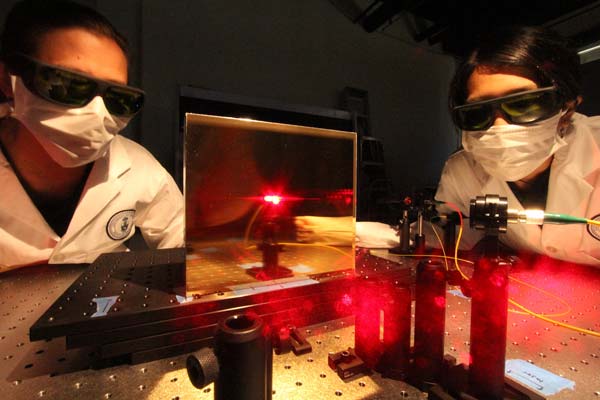
Astronomical evolution on display at U of T
Published: March 19, 2013
It's a glimpse into the world of scientists who study the stars, analyze the interaction of matter and radiated energy, and search for extra-terrestrial life.
On March 22, 2013, a team of graduate students in the Master of Museum Studies (MMSt) program at the University of Toronto will unveil their public exhibit showcasing the development of astronomical instrumentation at the David Dunlap Observatory (DDO) and the Dunlap Institute for Astronomy & Astrophysics.
The exhibit, titled “Innovators in Instrumentation: Advancing Astronomy at the Dunlap Institute”, portrays the evolution of astronomical instrumentation from the last century to today. It features historical artifacts from the DDO and instruments from the Dunlap Institute.
“While most people understand that astronomers use telescopes to observe the Universe, they are less aware that astronomers use instruments attached to those telescopes to truly understand the nature of the objects they’re observing,” says museum studies student, Emily Horne. “One of the mandates of the Dunlap Institute is to develop the instruments that will lead to ground-breaking discoveries.”
Spectrographs—instruments that separate starlight according to wavelength—are fundamental to astronomy. The exhibit includes a brass spectrograph used at the DDO when it began operation in the 1930s, as well as a simple spectrograph used today to teach U of T students.
 In addition to spectroscopy, the exhibit spotlights the work being done by Dunlap astronomers to establish a permanent observatory in the Canadian Arctic, with instruments dedicated to the search for planets beyond our Solar System. It also describes the work being done in the development of key instrumentation for the Thirty Meter Telescope which, when it is operational later this decade, will be the largest optical telescope every built. The exhibit also highlights the Dunlap’s own efforts to search for extraterrestrial intelligence, commonly known as SETI.
In addition to spectroscopy, the exhibit spotlights the work being done by Dunlap astronomers to establish a permanent observatory in the Canadian Arctic, with instruments dedicated to the search for planets beyond our Solar System. It also describes the work being done in the development of key instrumentation for the Thirty Meter Telescope which, when it is operational later this decade, will be the largest optical telescope every built. The exhibit also highlights the Dunlap’s own efforts to search for extraterrestrial intelligence, commonly known as SETI.
The exhibition project is a full-year course in the second year of the MMSt degree. As an alternative to doing a thesis, students can choose to do the project to gain hands-on experience with all facets of exhibition work, including design, curatorial practice, project management and collections management.
“Our team learned about this project through the University of Toronto Scientific Instruments Collection which preserves research tools used throughout history at U of T," says student Lauren Herzog. "We were excited for an opportunity to bring history and science together. The Dunlap’s work is fascinating, and now we get to share their work with the public.”
Over the course of the academic year, the students immersed themselves in astronomy and instrumentation, meeting with Dunlap astronomers to discuss their work.
“As we learned more about the Dunlap and were given the opportunity to work with some of the institution’s incredible faculty and postdocs, we knew we’d chosen a great project," says student Samantha Haddon. "They’ve been amazing to work with, and have explained complex astronomical principles, instruments and the discoveries they’ve lead to. We hope we’ve done the same for people who visit the exhibit.”
In addition to Haddon, Herzog and Horne the team of students includes: Laura Imrie, Claire MacDonald-Matthews and Amanda McGee.
“Innovators in Instrumentation” is free and open to the public and can be seen Monday through Friday, 9 am to 5 pm until October 2013, on the third floor of Victoria College.



